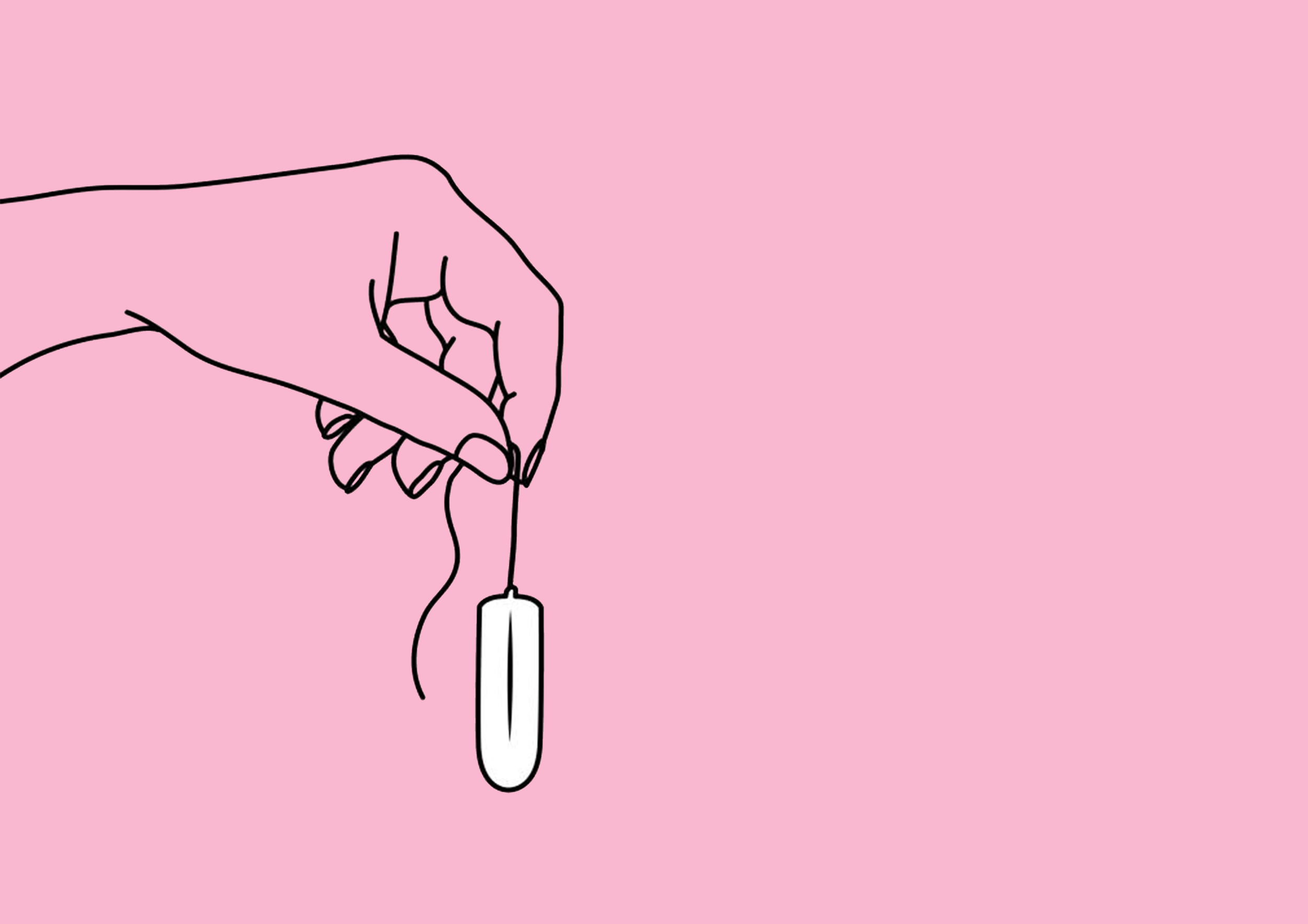Bloody Brilliant: Living With Endometriosis
Something that’s really important to us at The Unedit is maintaining and amplifying important conversations in a way that you may not typically find them elsewhere – and that oftentimes coincides with a lack of general awareness. When it comes to periods, a shockingly small number of people received what you would call a sufficient amount of education, which largely is at fault of the education system and the societal stigma around menstruation. With that, we wanted to offer a safe, detailed insight into periods for our readers, so we teamed up with organic tampon company, OHNE, for our latest series: Bloody Brilliant. Each month we’ll be tackling a different aspect within the world of menstruation and with the help of experts, we’ll be taking you far beyond the usual ‘time of the month’ spiel that your awkward school nurse might have given you.
Quick note from the author: So, cards on the table, I lost my mind a little writing this. I think I've pushed myself to the limits of the frustration and sadness I can handle while writing about women's pain and suffering with regard to under-researched and under-diagnosed diseases and conditions. This article was originally going to be about PCOS and Endometriosis, but 5,000 words in I knew we had a problem. I really wanted to do the stories of the women who shared their experiences with me justice - and cutting them down to fit both conditions and the stories of those living with each of them into a reasonable-length article just ain't it, chief. So we've decided to split them up, and post about Endometriosis on The Unedit, and PCOS over on OHNE's content platform. The Unedit's lovely founder Terri Waters has generously shared her experiences of PCOS with me, along with two of our OHNE ambassadors, and it's an good'un (if I do say so myself...)
A few months ago, I reached out to one of my best friends, Libby, who lives with Endometriosis, because, “like, my period pain shouldn’t be making it literally impossible for me to function.” I had started to suspect I might have the condition too and desperately needed to hear from someone who actually lived with it because I was sick of finding endless articles online that all said the same thing. They offered the same list of key symptoms, told me it’d be painful AF, and oh-by-the-way-there’s-no-known-cause-or-cure.
While I was experiencing ‘I don’t know if I’m going to pass out, vomit, or both’ level cramps, I had been led to believe that excruciating period pain was normal. Which is severely screwed up in and of itself, but it meant that I never really questioned my pain. That I just had to put up with it - an all too common (and overwhelmingly female) experience. For me, it was actually other, less extreme but far more insidious, symptoms that led to my suspicion that the “something” that was “wrong with me” could be Endometriosis. From brain fog, anxiety, and nausea to lethargy, non-restorative sleep, and random pains in my joints, I was forever googling the cause of a myriad of symptoms that I had no idea were connected. Endless googling of these symptoms eventually led me to Endometriosis - and they finally connected like a game of dots.
My journey hasn’t ended - not by a long shot. I’m still in the early stages of figuring out if I have it myself, starting with keeping a detailed cycle diary to show my doctor (you can use this template if you’re in the same position and unfamiliar with cycle tracking). Similarly, the world is still in the early stages of deciding to care about women’s pain. Research into Endometriosis is still thin and, unfortunately, there is still no cure or known cause. But the one thing I’ve realised we can’t keep doing is ignoring women’s pain. So, in addition to giving you an outline of what the hell Endometriosis actually is, you’re going to hear from some of the women who live with this condition everyday.
So what is it, exactly?
Put simply, Endometriosis is caused when tissue similar to the tissue that grows on the lining of the uterus starts to grow in other places around the body too. Usually this tissue will appear in areas close to the uterus, such as on the ovaries or fallopian tubes - but can be found anywhere in the body. And when I say anywhere, I mean anywhere. “I’ve had it on my bladder,” Katie Beals, an Endometriosis activist says, “ and I have it on my bowels”. The only place endometrial tissue has not been found is the spleen - it’s even been found on the brain. Moving swiftly on from that….
If endometrial tissue grows in the muscle layer of the wall of the womb, it is a similar but distinct condition called Adenomyosis. Someone with Adenomyosis doesn’t necessarily have endometriosis, and vice versa, but some people will experience both. Roughly a third of women with adenomyosis experience no symptoms.
Causes
No one is 100% sure what causes Endometriosis. There are many different theories about what causes it, but one of the most confusing facts of Endometriosis is that you don’t even need to have a period to have the condition - you don’t even need to have a uterus. Endometriosis has been found in women who have undergone hysterectomies and in cis men who have been exposed to oestrogen while participating in drug trials and treatments.
On theory posits that it is related to retrograde menstruation (click the link to read about what retrograde menstruation is and how it’s linked to Endometriosis, but note that the theory doesn’t explain cis men who have it or cis women - or trans men - who develop endo after a hysterectomy). Some of the other theories include the belief that some women are genetically predisposed to it, that it can be caused by immune dysfunctions, or even be caused by environmental causes such as dioxin exposure (yep, the same dioxin which is found in mainstream tampons. However, it has only been shown to be linked to the development of endometriosis in animals, not humans, and the exposure levels need to be significantly higher than the traces found in mainstream tampons). A leading theory is that it has to do with Metaplasia. This is when one type of cell morphs or changes into a different type of cell. Metaplasia would explain how the endometrial cells seem to appear spontaneously inside the body, as well as how they appear in areas such as the lungs and skin. It would explain the appearance of the cells in women with no womb or in men who have had hormone treatments. Some researchers believe this type of cell-change happens inside the womb, as the baby’s body, specifically it’s uterus, is growing (metaplasia allows for the natural growth of the human body inside the womb). Others believe that some adult cells retain the ability they had in the womb to transform into Endometriosis cells.
Symptoms
The three main symptoms of endometriosis are experiencing painful periods and painful sex as well as infertility. Libby says “I pretty much experience pain at least three weeks of the month. During my period and when I’m ovulating are when I experience the worst pain… It’s really hard to explain the severity of the pain - [it] completely rules my body.” The level of pain a person experiences is not (necessarily) correlated to the amount of disease they have - it varies completely from person to person.
There are myriad symptoms beyond these three that help us to understand what living with Endometriosis is actually like. Pain-related symptoms include:
pain starting before periods
pain after and/or during sex
pain during ovulation
pain during internal examination
leg pain
back pain
pain before, during, and/or after bladder or bowel movements as well as bleeding from the bowel or blood in the urine
Symptoms not related to pain but related to bleeding include having heavy periods with or without blood clots, prolonged bleeding, premenstrual spotting, irregular periods, loss of dark or old blood right before a period or at the end of a period. Diarrhea, constipation, and colic can also be symptoms, as is experiencing frequent infections such as thrush.
Libby describes one of her most common symptoms as ‘the Endo belly’ - “it’s a constant pressure on my abdomen that becomes rock solid and so tender - even just brushing past something can hurt. There’s the added bonus of not having anything comfortable to wear!”
The emotional symptoms of Endometriosis are often overlooked in favour of focusing on the severity of the dysmenorrhea (AKA period pain), but they can be just as important - and just as debilitating. Lethargy, extreme tiredness, nausea, depression, and feeling faint (or actually fainting) during your periods are common in people with Endometriosis. In and of themselves, these symptoms can seem fairly innocuous. ‘I obviously haven’t slept enough’, ‘I’m probably just stressed’, ‘maybe I ate something funny’, ‘maybe it’s PMS’... the list of ways we can brush off our minor ailments is endless - not to mention the ways in which we’re taught to ignore our pain.
Katie Beals, who shared her story in Hannah Witton’s Periods, Hormones, and Contraception Roundtable, which you should 100% watch, says that, pre-diagnosis, “as soon as I had my period I was in bed crying, it was so painful it made me sick and I thought that was normal because I was never taught otherwise.”
And there’s the rub. Society dismisses, disbelieves, and downplays women’s pain to the point that many if not most of us grow up thinking that pain is simply normal. Even if it’s excruciating, even if it has us unable to get out of bed, go to work, or function as normal. And we’re never taught to question it or demand answers. We’re just taught to get on with it.
Krystal Rodriguez, who used her platform on Instagram (where she has almost 30k followers) to raise awareness for Endometriosis right before she went in for surgery, told OHNE that the best part of her diagnosis experience was when her pain was finally validated. She says she’ll never forget the moment the doctor told her she must be in a lot of pain. “The floodgates opened… Someone finally understood what I was going through.” Having someone believe her pain and want to help her changed everything - she no longer felt as confused and scared as she had before. Simply believing women’s pain is the first step to freeing so many of us from it.
Diagnosis
Getting diagnosed with Endometriosis is not always simple. In fact, it takes an average of six to ten years from the onset of symptoms to get a diagnosis. For Katie, it took nine years to get an official diagnosis. Libby, now 24, was eighteen when she first began investigating her symptoms and what they meant.
In the past six years, Libby’s been told she has an STI - “even though I knew there was NO way I did” - been dismissed with the assertion that period pain is ‘perfectly normal’, and, outrageously, been told that it’d be best if she didn’t know what was wrong with her as “it makes some women obsessed with the pain.”
Krystal, too, had to endure a series of negative experiences with doctors before getting an Endometriosis diagnosis from a doctor she trusted (I’m not out here trying to put you all off going for scans if you need ‘em, but you can read about her experience going for a scan that, sounds, frankly, traumatising here).
Officially, Endometriosis is diagnosed with a laparoscopy, a kind of keyhole surgery in which the doctor uses a camera to look inside the abdomen and takes a sample of a suspected endometriosis lesion. While Krystal and Katie have both had these surgeries, Libby has decided to forgo it for the meantime. “I’m considering it,” she says, “but my main fear, and the reason my mental health really suffers over it, is my huge desire to have children. Infertility or difficulty conceiving is really common in women who suffer from Endometriosis.” She is overcoming her fear of what the doctors might find, however, because “it’s got to the point where I want to know my chances of having children, even if that means starting earlier than I had originally planned. I’m very lucky to have the huge support from my partner.”
Treatments, surgeries, and pain management
Again, there’s no cure for Endometriosis, but there are ways to deal with it, from home remedies, to prescribed pain medication, to surgeries.
When it comes to surgeries, Katie says what you don’t want is Ablation surgery, which involves burning away the Endometriosis. “You have to think of it like an iceberg, if you burn it away you’re just getting that tip and there’s that bulk of it left behind.” She later found out about Excision surgery, which involves a similar procedure but the Endometriosis is cut away. “And they get that whole iceberg,” Katie says, “if you have a really good surgery you shouldn’t need to have these repeat surgeries” - which is a problem with Ablation surgery.
Not yet at the stage where she knows if she needs surgery, Libby’s best friend is her long hot water bottle. “I wrap that around my stomach and it usually helps relieve some of the pain. I actually use it so much I’ve developed a hot water bottle rash on my stomach and the insides of my thighs - which looks horrific but I’m kind of beyond caring if it dulls the pain!” The rash she speaks of has a name - Erythema ab inge (no I didn’t just slam my keyboard, that’s it’s real name) is caused by excess exposure to heat and can result in hyperpigmentation, redness, and dilated blood vessels. For some it was cause itching and burning but in other cases it might only be an aesthetic issue.
She’s also trying medication for the first time: tranexamic acid and mefenamic acid.”To be honest, I’m not a medication type gal. In the past, my mental health has convinced me I’m just being a wuss and should just deal with the pain.” But she says she’s giving it a go out of “pure desperation” for pain relief. She also vapes strong CBD and says she’s exploring some other CBD products available, but hasn’t yet found one that makes her feel as good as cuddling with her dog - the most adorable blue staffy named Kimchi.
The round-up
Despite affecting an estimated one in ten women, Endometriosis is severely under-researched. I can’t tell you how much it pains me that such a big part of my job - writing about periods for a living - involves writing the words “no cure,” “difficult to diagnose” and “no known cause” as any times as I do. It’s absolutely shocking that people of marginalised genders are living with chronic pain because society - and, by extension, the medical profession - doesn’t care enough to fund research and cures for conditions which affect the lives of people with periods in debilitating ways.
To find out more about Endometriosis, check out Endometriosis UK. It’s a brilliant charity that supports women living with endometriosis and is a wealth of information on the subject. Whether you think you might have Endometriosis or you, like me, are experiencing a confusing cocktail of symptoms that indicate that something’s not quite right, go to your doctor. Don’t downplay your own pain - society does that enough for us. To paraphrase Krystal in her interview with OHNE, listen to your body and don’t take it for granted.








